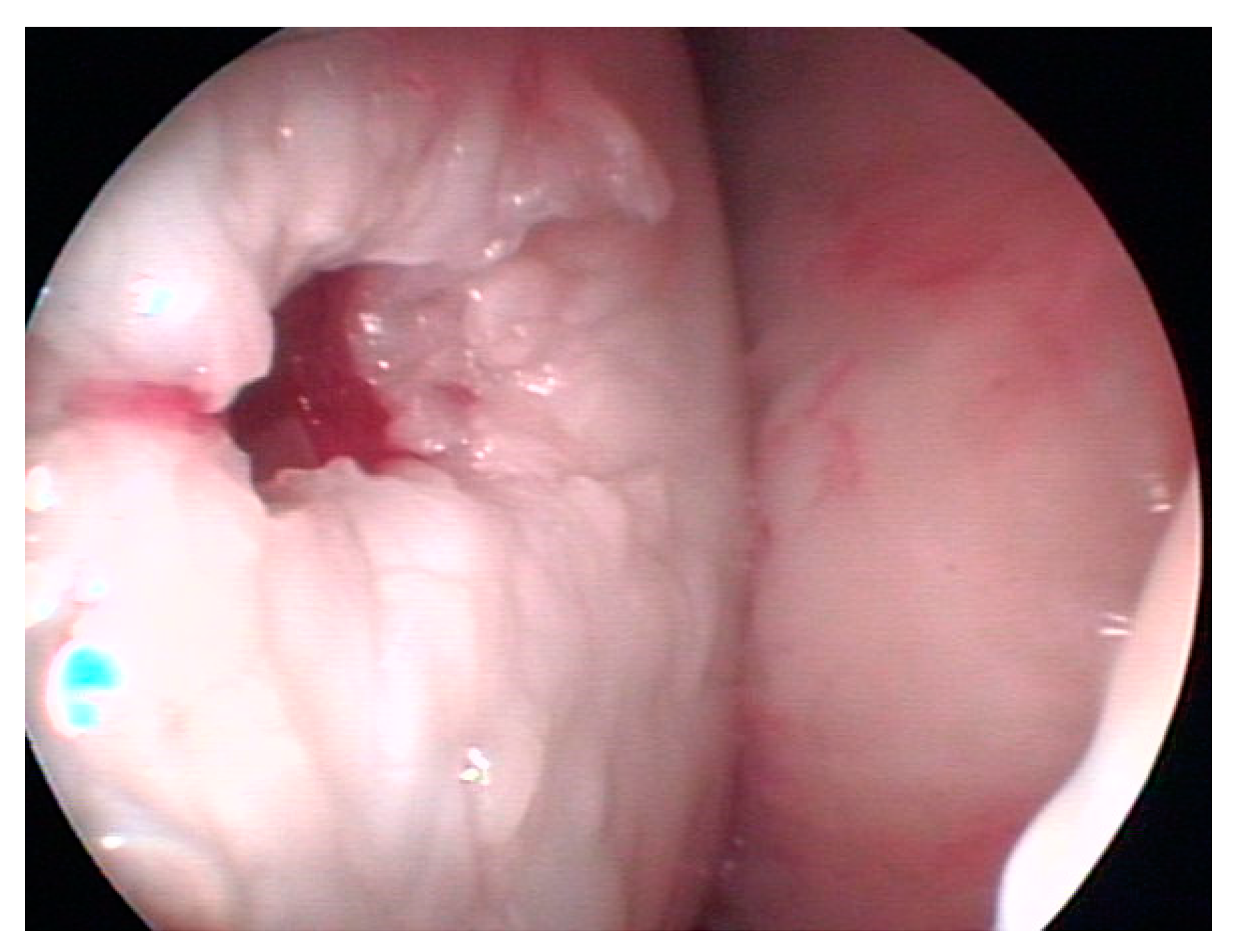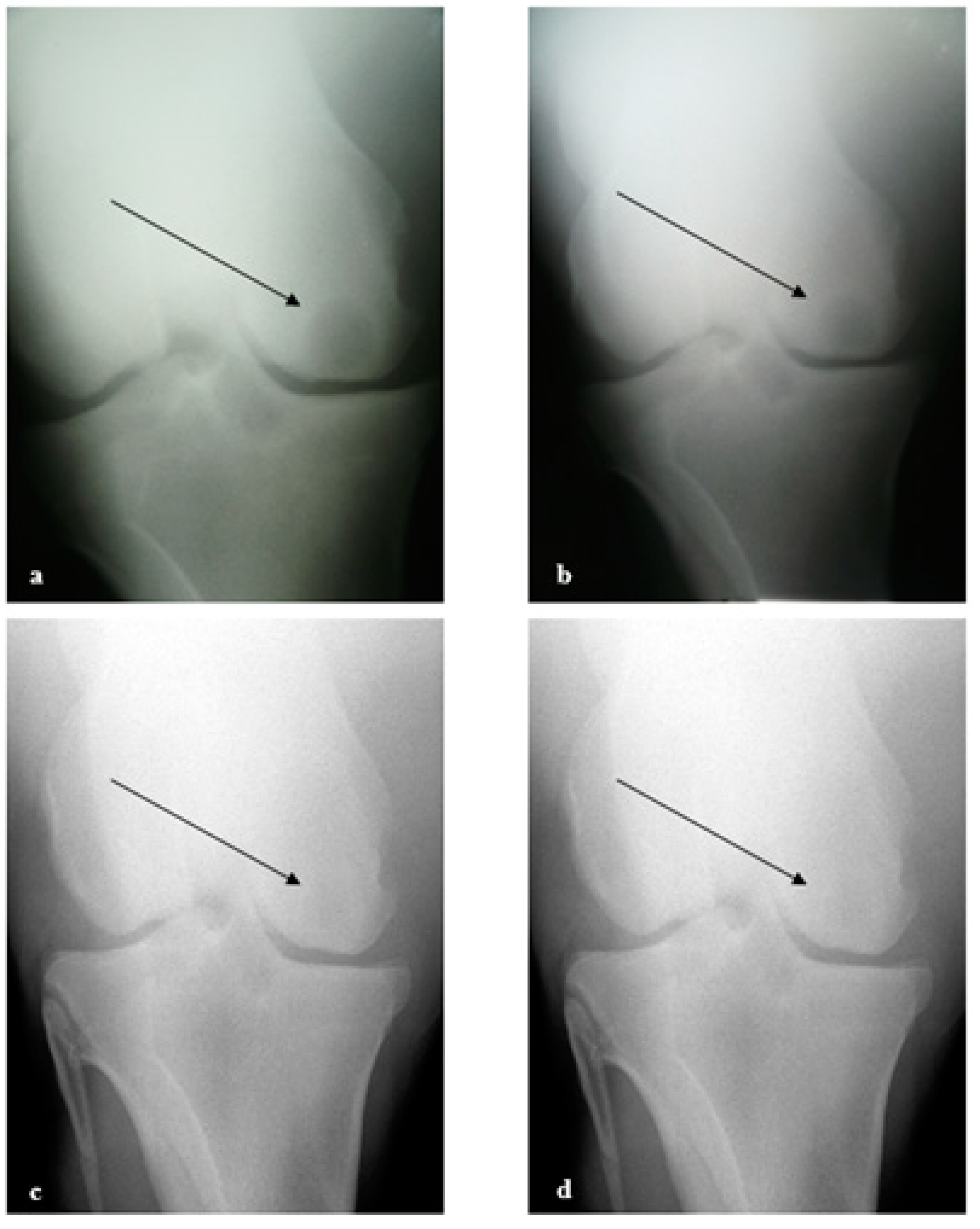Arthroscopic Treatment of a Subchondral Bone Cyst via Stem Cells Application: A Case Study in Equine Model and Outcomes
Abstract
:1. Introduction
2. Materials and Methods
2.1. Isolation of Mesenchymal Stromal Cells from Adipose Tissue
2.2. Differentiation of Mesenchymal Stromal Cells
2.3. Preparation of Platelet Gel Containing AMSCs for the Treatment of Bone Cyst
2.4. Surgical Treatment of the Clinical Case
2.5. Radiographic Analysis
3. Results
3.1. Bone Cyst Treatment
3.2. Clinical Evaluation
4. Discussion
5. Conclusions
Author Contributions
Funding
Institutional Review Board Statement
Informed Consent Statement
Data Availability Statement
Conflicts of Interest
References
- Frazer, L.L.; Santschi, E.M.; Kenneth, J.; Fischer, K.J. The impact of subchondral bone cysts on local bone stresses in the medial femoral condyle of the equine stifle joint. Med. Eng. Phys. 2017, 48, 158–167. [Google Scholar] [CrossRef] [PubMed]
- Von Rechenberg, B.; McIlwraith, C.W.; Leutenegger, C.; Akens, M.K. Fibrous Tissue of Subchondral Cystic Lesions in Horses Produce Local Mediators and Neutral Metalloproteinases and Cause Bone Resorption in vitro. Vet. Surg. 2000, 29, 420–429. [Google Scholar] [CrossRef] [PubMed]
- Jenner, F. Treatment of osseous cyst-like lesions. Equine Vet. Educ. 2020, 33, 345–348. [Google Scholar] [CrossRef]
- Ohlerth, S.; Dennler, M.; Rüefli, E.; Hauser, B.; Poirier, V.; Siebeck, N.; Roos, M.; Kaser-Hotz, B. Contrast harmonic imaging characterization of canine splenic lesions. J. Vet. Intern. Med. 2008, 22, 1095–1102. [Google Scholar] [CrossRef]
- Frazer, L.L.; Santschi, E.M.; Ring, S.J.; Hewitt, R.E.; Fischer, K.J. Impact of Size and Shape of Equine Femoral Subchondral Bone Cysts with a Transcondylar Screw on Predicted Bone Formation Area in a Finite Element Model. ASME J. Biomech. Eng. 2020, 142, 061010-1–061010-8. [Google Scholar] [CrossRef]
- Peter, V.G.; O’Keeffe, T.A.; Smith, L.C.R.; Schweizer-Gorgas, D. Radiographic Identification of Osseous Cyst-Like Lesions in the Distal Phalanx in 22 Lame Thoroughbred Horses Managed Conservatively and Their Racing Performance. Front. Vet. Sci. 2018, 5, 286. [Google Scholar] [CrossRef] [PubMed]
- Riley, C.B.; Scott, W.M.; Caron, J.P.; Fretz, P.B.; Bailey, J.V.; Barber, S.M. Osteochondritis dessicans and subchondral cystic lesions in draft horses: A retrospective study. Can. Vet. J. 1998, 39, 627–633. [Google Scholar] [PubMed]
- Walker, W.T.; Silverberg, J.L.; Kawcak, C.E.; Nelson, B.B.; Fortier, L.A. Morphological characteristics of subchondral bone cysts in medial femoral condyles of adult horses as determined by computed tomography. Am. J. Vet. Res. 2016, 77, 265–274. [Google Scholar] [CrossRef]
- Kaspiris, A.; Hadjimichael, A.C.; Lianou, I.; Iliopoulos, I.D.; Ntourantonis, D.; Melissaridou, D.; Savvidou, O.D.; Papadimitriou, E.; Chronopoulos, E. Subchondral Bone Cyst Development in Osteoarthritis: From Pathophysiology to Bone Microarchitecture Changes and Clinical Implementations. J. Clin. Med. 2023, 12, 815. [Google Scholar] [CrossRef]
- Bonilla, A.G.; Bertone, A.L.; Brokken, M.T.; Santschi, E.M. Concurrent or sequential tibial subchondral cystic lesions in 4 horses with medial femoral condyle subchondral cystic lesions. J. Am. Vet. Med. Assoc. 2016, 249, 1313–1318. [Google Scholar] [CrossRef]
- Foerner, J.J.; James, S.; Juzwiak, J.S.; Bruce, C.; Watt, B.C.; Keuler, N.S.; Santschi, E.M. Injection of Equine Subchondral Bone Cysts with Triamcinolone: 73 Horses (1999–2005). AAEP Proc. 2006, 52, 412–413. [Google Scholar]
- Hogan, P.M.; McIlwraith, C.; Honnas, C.J.; Watkins, L. Bramlage Surgical treatment of subchondral cystic lesions of the third metacarpal bone: Results in 15 horses. EVJ 1997, 29, 477–482. [Google Scholar] [CrossRef]
- Story, M.R.; Bramlage, L.R. Arthroscopic debridement of subchondral bone cysts in the distal phalanx of 11 horses (1994–2000). Equine Vet. J. 2004, 36, 356–360. [Google Scholar] [CrossRef] [PubMed]
- Goodrich, L.R.; Mcilwraith, C.W. Subchondral bone cysts—Not always an easy diagnosis. Equine Vet. Educ. 2008, 20, 521–524. [Google Scholar] [CrossRef]
- Tobita, M.; Tajima, S.; Mizuno, H. Adipose tissue-derived mesenchymal stem cells and platelet-rich plasma: Stem cell transplantation methods that enhance stemness. Stem Cell Res. Ther. 2015, 6, 215. [Google Scholar] [CrossRef] [PubMed]
- Mastrogiacomo, M.; Nardini, M.; Collina, M.C.; Di Campli, C.; Filaci, G.; Cancedda, R.; Odorisio, T. Innovative Cell and Platelet Rich Plasma Therapies for Diabetic Foot Ulcer Treatment: The Allogeneic Approach. Front. Bioeng. Biotechnol. 2022, 10, 869408. [Google Scholar] [CrossRef] [PubMed]
- Pendleton, C.; Li, Q.; Chesler, D.A.; Yuan, K.; Guerrero-Cazares, H.; Quinones-Hinojosa, A. Mesenchymal Stem Cells Derived from Adipose Tissue vs. Bone Marrow: In Vitro Comparison of Their Tropism towards Gliomas. PLoS ONE 2013, 8, e58198. [Google Scholar] [CrossRef]
- Si, Z.; Wang, X.; Sun, C.; Kang, Y.; Xu, J.; Wang, X.; Hui, Y. Adipose-derived stem cells: Sources, potency, and implications for regenerative therapies. Biomed. Pharmacother. 2019, 114, 108765. [Google Scholar] [CrossRef]
- Stage, H.J.; Trappe, S.; Söllig, K.; Trachsel, D.S.; Kirsch, K.; Zieger, C.; Merle, R.; Aschenbach, J.R.; Gehlen, H. Multilineage Differentiation Potential of Equine Adipose-Derived Stromal/Stem Cells from Different Sources. Animals 2023, 13, 1352. [Google Scholar] [CrossRef]
- Petrova, V.; Vachkova, E. Outlook of Adipose-Derived Stem Cells: Challenges to Their Clinical Application in Horses. Vet. Sci. 2023, 10, 348. [Google Scholar] [CrossRef]
- Canonici, F.; Cocumelli, C.; Cersini, A.; Marcoccia, D.; Zepparoni, A.; Altigeri, A.; Caciolo, D.; Roncoroni, C.; Monteleone, V.; Innocenzi, E.; et al. Articular Cartilage Regeneration by Hyaline Chondrocytes: A Case Study in Equine Model and Outcomes. Biomedicines 2023, 11, 1602. [Google Scholar] [CrossRef]
- Qi, Y.; Niu, L.; Zhao, T.; Shi, Z.; Di, T.; Feng, G.; Li, J.; Huang, Z. Combining mesenchymal stem cell sheets with platelet-rich plasma gel/calcium phosphate particles: A novel strategy to promote bone regeneration. Stem Cell Res. Ther. 2015, 6, 256. [Google Scholar] [CrossRef]
- Ribitsch, I.; Baptista, P.M.; Lange-Consiglio, A.; Melotti, L.; Patruno, M.; Jenner, F.; Schnabl-Feichter, E.; Dutton, L.C.; Connolly, D.J.; van Steenbeek, F.G.; et al. Large Animal Models in Regenerative Medicine and Tissue Engineering: To Do or Not to Do. Front. Bioeng. Biotechnol. 2020, 8, 972. [Google Scholar] [CrossRef]
- Ravanetti, P.; Lechartier, A.; Hamon, M.; Zucca, E. A composite absorbable implant used tontreat subchondral bone cysts in 38 horses. Equine Vet. J. 2021, 54, 97–105. [Google Scholar] [CrossRef] [PubMed]
- Santschi, E.M.; Williams, J.M.; Morgan, J.W.; Johnson, C.R.; Bertone, A.L.; Juzwiak, J.S. Preliminary investigation of the treatment of equine medialfemoral condylar subchondral cystic lesions with a transcondylar screw. Vet. Surg. 2015, 44, 281–288. [Google Scholar] [CrossRef]
- Young, N.; Barker, W.; Minshall, G.; Wright, I. Arthroscopically guided lag screw fixation of subchondral bone cyst in the medial femoral condyle in Thoroughbred racehorses: Description of thechnique and comparative results. Vet. Surg. 2023, 1–11. [Google Scholar] [CrossRef] [PubMed]
- Fortier, L.A.; Nixon, A.J.; Williams, J.; Cable, C.S. Isolation and chondrocytic differentiation of equine bone marrow-derived mesenchymal stem cells. Am. J. Vet. Res. 1998, 59, 1182–1187. [Google Scholar] [PubMed]
- Klein, C.E.; Bramlage, L.R.; Stefanovski, D.; Ruggles, A.J.; Embertson, R.M.; Hopper, S.A. Comparative results of 3 treatments for medial femoral condyle subchondral cystic lesions in Thoroughbred racehorses. Vet. Surg. 2022, 51, 455–463. [Google Scholar] [CrossRef]




Disclaimer/Publisher’s Note: The statements, opinions and data contained in all publications are solely those of the individual author(s) and contributor(s) and not of MDPI and/or the editor(s). MDPI and/or the editor(s) disclaim responsibility for any injury to people or property resulting from any ideas, methods, instructions or products referred to in the content. |
© 2023 by the authors. Licensee MDPI, Basel, Switzerland. This article is an open access article distributed under the terms and conditions of the Creative Commons Attribution (CC BY) license (https://creativecommons.org/licenses/by/4.0/).
Share and Cite
Canonici, F.; Marcoccia, D.; Bonini, P.; Monteleone, V.; Innocenzi, E.; Zepparoni, A.; Altigeri, A.; Caciolo, D.; Tofani, S.; Ghisellini, P.; et al. Arthroscopic Treatment of a Subchondral Bone Cyst via Stem Cells Application: A Case Study in Equine Model and Outcomes. Biomedicines 2023, 11, 3307. https://doi.org/10.3390/biomedicines11123307
Canonici F, Marcoccia D, Bonini P, Monteleone V, Innocenzi E, Zepparoni A, Altigeri A, Caciolo D, Tofani S, Ghisellini P, et al. Arthroscopic Treatment of a Subchondral Bone Cyst via Stem Cells Application: A Case Study in Equine Model and Outcomes. Biomedicines. 2023; 11(12):3307. https://doi.org/10.3390/biomedicines11123307
Chicago/Turabian StyleCanonici, Fernando, Daniele Marcoccia, Pamela Bonini, Valentina Monteleone, Elisa Innocenzi, Alessia Zepparoni, Annalisa Altigeri, Daniela Caciolo, Silvia Tofani, Paola Ghisellini, and et al. 2023. "Arthroscopic Treatment of a Subchondral Bone Cyst via Stem Cells Application: A Case Study in Equine Model and Outcomes" Biomedicines 11, no. 12: 3307. https://doi.org/10.3390/biomedicines11123307
APA StyleCanonici, F., Marcoccia, D., Bonini, P., Monteleone, V., Innocenzi, E., Zepparoni, A., Altigeri, A., Caciolo, D., Tofani, S., Ghisellini, P., Rando, C., Pechkova, E., Rau, J. V., Eggenhöffner, R., Scicluna, M. T., & Barbaro, K. (2023). Arthroscopic Treatment of a Subchondral Bone Cyst via Stem Cells Application: A Case Study in Equine Model and Outcomes. Biomedicines, 11(12), 3307. https://doi.org/10.3390/biomedicines11123307










